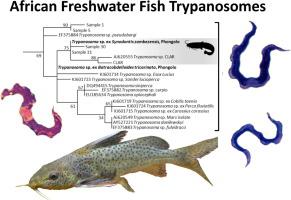International Journal for Parasitology ( IF 3.7 ) Pub Date : 2020-07-17 , DOI: 10.1016/j.ijpara.2020.06.004 Nico J Smit 1 , Adri Joubert 1 , Scott P Lawton 2 , Polly M Hayes 3 , Courtney A Cook 1

|
Trypanosomes are ubiquitous blood parasites of fishes and at least 16 species were originally described infecting African freshwater fishes. This number was later reduced to six and in the late 1990s it was proposed that most records of freshwater fish trypanosomes across Africa are Trypanosoma mukasai Hoare, 1932. Recently, results from a molecular analysis of fish trypanosomes from the Okavango Delta, Botswana, reported the presence of at least two genotypic groups and concluded that the identification of T. mukasai remains problematic. The aims of the present study were thus to elucidate the life cycle of a freshwater fish trypanosome from southern Africa and to do a morphological and molecular characterization of this parasite from both the fish host and leech vector. To locate trypanosome stages, leeches were removed from fishes captured in the Phongolo River, South Africa, and fish blood films and leech squashes were Giemsa-stained and screened. To determine whether trypanosome stages in fishes and leeches were of the same genotype, DNA was extracted and fragments of the 18S rDNA gene were amplified and sequenced. Trypanosomes were detected in the fish families Cichlidae, Clariidae, Mochokidae and Schilbeidae. Sequence data showed that the trypanosome from one of the leeches, identified as Batracobdelloides tricarinata (Blanchard, 1897), was highly similar to those obtained from the plain squeaker, Synodontis zambezensis, with 0.7% difference recorded between them. From morphological and molecular data presented here, it is clear that the trypanosomes from Phongolo are closely related to those of the Okavango and should be considered as a single diverse species with genetic differentiation between 0.4–2.9%, under the 3–5% differences expected to be seen between true distinct species within the rRNA. Developmental stages of the trypanosome found in the leech B. tricarinata supports its status as the vector and the molecular evidence shows the relationship between the trypanosome in the fish and leech, but also illustrates the exceptional genetic and morphological diversity of a single species of trypanosome between host species. The work presented here provides us with clear information to take further steps in resolving the taxonomy and systematics of African freshwater fish trypanosomes.
中文翻译:

非洲淡水鱼锥虫的形态和分子特征,包括其在水蛭载体中的发育。
锥虫是鱼类中普遍存在的血液寄生虫,至少有 16 种物种最初被描述感染非洲淡水鱼。这个数字后来减少到 6 个,在 1990 年代后期,有人提出非洲大部分淡水鱼锥虫的记录是1932 年的Trypanosoma mukasai Hoare。最近,博茨瓦纳奥卡万戈三角洲鱼类锥虫的分子分析结果报告说:至少存在两个基因型组并得出结论,T. mukasai的鉴定仍然有问题。因此,本研究的目的是阐明来自南部非洲的淡水鱼锥虫的生命周期,并对来自鱼类宿主和水蛭载体的这种寄生虫进行形态学和分子表征。为了定位锥虫阶段,从南非 Phongolo 河捕获的鱼类中取出水蛭,并对鱼血膜和水蛭南瓜进行吉姆萨染色和筛选。为了确定鱼类和水蛭的锥虫阶段是否具有相同的基因型,提取了 DNA 并对 18S rDNA 基因的片段进行了扩增和测序。锥虫在鱼科丽鱼科、克拉里科、莫乔基科和鱼科中被检测到。序列数据显示,其中一只水蛭的锥虫被鉴定为Batracobdelloides tricarinata(Blanchard, 1897),与从普通鸣叫Synodontis zambezensis获得的那些非常相似,记录它们之间的差异为 0.7%。从这里提供的形态和分子数据来看,很明显,来自 Phongolo 的锥虫与 Okavango 的锥虫密切相关,应被视为一个单一的多样化物种,遗传分化在 0.4-2.9% 之间,低于预期的 3-5% 差异在 rRNA 中真正不同的物种之间可以看到。在水蛭B. tricarinata 中发现的锥虫的发育阶段支持其作为载体的地位,分子证据显示了鱼和水蛭中的锥虫之间的关系,但也说明了宿主物种之间单个锥虫物种的特殊遗传和形态多样性。此处介绍的工作为我们提供了明确的信息,以采取进一步措施解决非洲淡水鱼锥虫的分类和系统学问题。











































 京公网安备 11010802027423号
京公网安备 11010802027423号